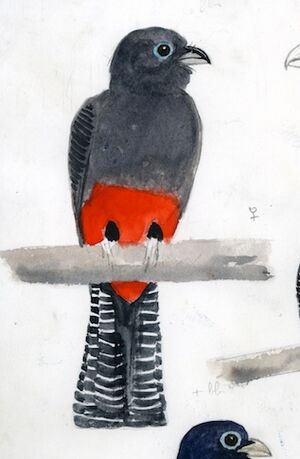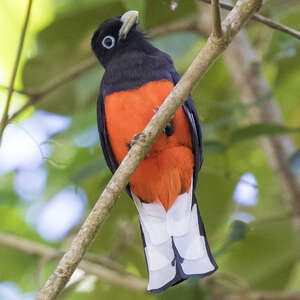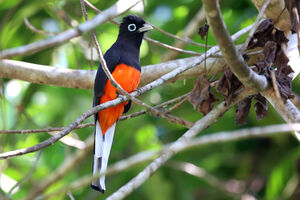Baird's Trogon
Trogon bairdii - Trogon de Baird
Identification
George Newbold Lawrence, an American ornithologist (1806-1895), discovered Baird's Trogon in 1868 in San Mateo, Costa Rica and so named it in honor of Spencer Fullerton Baird (1823-1887), another American ornithologist, his friend and colleague with whom he made several expeditions. As with all trogons, Baird's Trogon has a peculiarity that makes each member of the trogonidae family unique: it is the only trogon with a red belly and blue beak and scientists believe it forms a super-species with Trogon viridis, citroleus and melanocephalus. Baird's Trogon measures from 25 to 28 cm, with a clear dimorphism, the male has the pale blue beak which is an unmistakable distinctive element, the beak color is matched to its orbital circle of the same pale blue, the iris is black. The black eyebrow contrasts little with the cap and neck of a dark blue-sea, depending on the light this blue will tint purple. The mantle, back and shoulder blades are emerald green, there too the light will play its role, depending on its exposure, the bird will sometimes look turquoise blue, violet blue or downright purple! The feathers are gray and the characteristic vermiculations of many trogons are absent, the remiges are almost black anthracite with quite clear white edgings. The chest is black on its central part and on the edges near the feathers, slightly tinted with the same blue-sea found on the nape and cap. The belly is orange-red, the lower rectrices are white and end with a black horizontal line, the upper rectrices presenting a green-bronze color with turquoise blue reflections. The tarsi are blue-gray. The female has a grayer beak with a black upper jaw, the cap and neck are anthracite, the brows, throat and chest are gray, the belly remains orange-red with an orange dominant than the male.The mantle, back and scapulars are anthracite, the dark gray coverts are painted with very faint white horizontal wavy lines, the remiges are identical to the male: black with white edges. The tail is completely different from the male, the lower rectrices are horizontally striped grey and white, the base of the tail near the abdomen being only anthracite like the upper rectrices. Juveniles resemble their mother, young males show the first green reflections of their adult plumage on the back, the lower rectrices are vaguely striped before becoming white for males and striped for females.
Subspecific information monotypic species
Foreign names
- Trogon de Baird,
- Trogón de Baird,
- surucuá-de-barriga-encarnada,
- Bairdtrogon,
- Baird-trogon,
- Bairds Trogon,
- Trogone di Baird,
- bairdtrogon,
- Blåryggtrogon,
- trogón panamský,
- trogon Bairdův,
- Blårygget Trogon,
- sinirintatrogoni,
- trogon de Baird,
- trogon panamski,
- Настоящий трогон,
- パナマハグロキヌバネドリ,
- 拜氏美洲咬鹃,
- blåryggig trogon,
- 貝爾德氏美洲咬鵑,
Voice song and call
The bird is not always easy to see, so you hear it! A series of fast and sharp coo-coo-coo-coo-coo that diminish in intensity at the end of the stance. Alexander Skutch, American ornithologist (1904-2004), noticed that Baird's Trogon had a wide range of vocalisations, the male, during the breeding period from February to May in Costa Rica, could sing for 30 minutes to call a female and mark its territory. During the incubation, the female signals her partner that she wants to stretch her wings by repeating a tuck-tuck-tuck and that he must replace her.
Habitat
Behaviour character trait
The Baird's Trogon is a sedentary species, staying on the Pacific-facing side of Central America's cordillera with no observed migration.
Dietfeeding habits
Baird's Trogon is a frugivore but it clearly enjoys all types of insects, such as orthopterans, caterpillars, mantises and various larvae which it captures from a branch. On occasion, small lizards are also on the menu!
Reproduction nesting
Skutch observed, in Costa Rica, the first signs of nest construction in early March, with the actual building beginning in April. Baird's Trogon will excavate into a decaying tree, usually at an average height of 15 m, often in a spathodea (magnolia family tree). The male chooses the tree and the pair will then work together to dig an ascending tunnel of about 18 cm long and 8 cm in diameter up to the chamber where both parents will incubate 2-3 eggs for 16-17 days. The eggs are often laid with a day's interval. The pair alternately feed the chicks with insects, the fledglings leave the nest after 25 days. The mortality rate of the chicks seems quite high, predation, climate and bad weather not making it easy to raise them.
Geographic range
Threats - protection
IUCN conservation status
concern
in the Wild
threatened
evaluated
Near Threatened (NT) by the IUCN, Baird's Trogon is estimated to have a total population of between 1,000 and 5,000 individuals over a total area of 12,500km2. Deforestation and population expansion pose a real threat to one of the rarest Neotropical trogons. The bird is almost never seen in Panama anymore. Too closely connected to its small distribution area, it continues to persist in national parks, but for how much longer?
Sources of information
- IOC World Bird List (v15.1), Gill, F and D Donsker (Eds). 2025-12-07.
- A Natural history of the Trogonidae, Joseph M.Forshaw Albert Earl Gilbert
- The Birds of Panama, George R.Anger Robert Dean
- Vol. 6 - Handbook of the Birds of the World, Josep del Hoyo-Andrew Elliott-Jordi Sargatal
- xeno-canto, Sharing bird sounds from around the world,
- Avibase, Lepage Denis
- BirdLife International, BirdLife International
- Wikipédia, Wikipedia, The Free Encyclopedia
Other sources of interest
 Specification sheet created on
02/08/2023 by Anne et Gabriel Leboff
Specification sheet created on
02/08/2023 by Anne et Gabriel LeboffTranslation by AI Oiseaux.net
© 1996-2025 Oiseaux.net
- Accipitriformes
- Aegotheliformes
- Anseriformes
- Apodiformes
- Apterygiformes
- Bucerotiformes
- Caprimulgiformes
- Cariamiformes
- Casuariiformes
- Charadriiformes
- Ciconiiformes
- Coliiformes
- Columbiformes
- Coraciiformes
- Cuculiformes
- Eurypygiformes
- Falconiformes
- Galliformes
- Gaviiformes
- Gruiformes
- Leptosomiformes
- Mesitornithiformes
- Musophagiformes
- Nyctibiiformes
- Opisthocomiformes
- Otidiformes
- Passeriformes
- Pelecaniformes
- Phaethontiformes
- Phoenicopteriformes
- Piciformes
- Podargiformes
- Podicipediformes
- Procellariiformes
- Psittaciformes
- Pterocliformes
- Rheiformes
- Sphenisciformes
- Steatornithiformes
- Strigiformes
- Struthioniformes
- Suliformes
- Tinamiformes
- Trogoniformes







